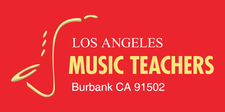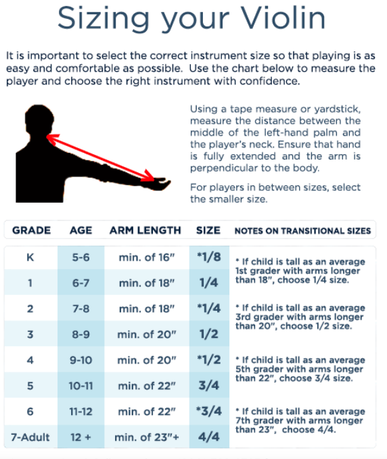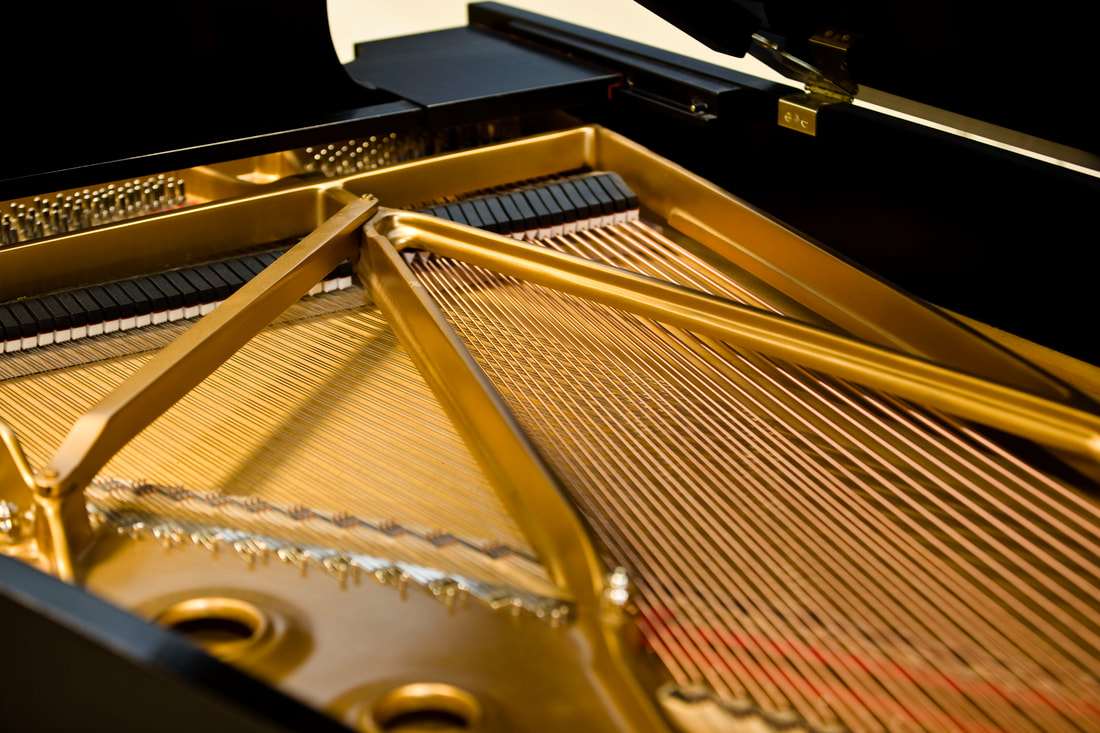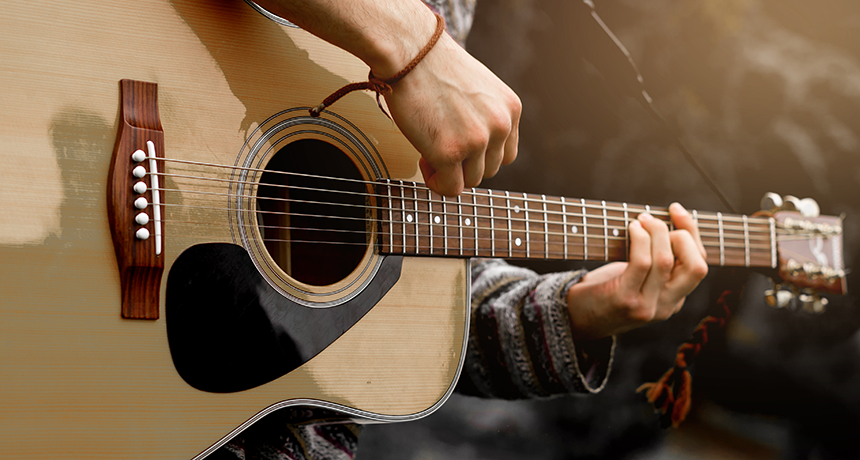If you're interested in taking Violin lessons on Zoom or In Person in Burbank, Glendale or North Hollywood, we have some of the best Violin lessons in Los Angeles. Our violin instructors are picked by interviewing hundreds of violin instructors and we have really high standards on both their teaching ability as well as their personality. If you'd like to talk to one of our instructors or set up a first lesson we have a guarantee that if you don't absolutely love your first lesson you don't have to pay for it. Please contact us at (818)902-1233 or on our website at https://www.losangelesmusicteachers.com/online-violin-lessons-in-burbank-ca.html Many teachers prefer students to use the length from the neck to the wrist for measurement instead of the neck to mid-palm approach. The violin size determined by the neck/wrist approach would be the size that is more comfortable for students to hold. The violin size determined by the neck/mid-palm approach would be the biggest size students should use. By using our chart, you will find the size which most probably will be the best for your child.
Piano lessons for just any child. In many cases you’ve heard people say how they wished they had taken some piano lessons, or how they wish they had not quit their lessons. Unfortunately for most of these people the realization comes too late, long after the opportunity has gone past. If you are considering signing up you kids for piano lesson, it certainly is something worth going for. Piano lessons pose many cognitive benefits for the little ones, even if the opportunity is short-lived. If you're interested in taking Piano lessons on Zoom or In Person in Burbank, Glendale or North Hollywood, we have some of the best piano lessons in Los Angeles. Our piano instructors are picked by interviewing hundreds of drum instructors and we have really high standards on both their teaching ability as well as their personality. If you'd like to talk to one of our instructors or set up a first lesson we have a guarantee that if you don't absolutely love your first lesson you don't have to pay for it. Please contact us at (818)902-1233 or on our website at https://www.losangelesmusicteachers.com/online-piano-lessons-in-burbank-ca.html
Top 10 Things Beginners Will Learn in Their First Guitar Lessons Are you thinking of learning how to play the guitar? When learning any new musical instrument, you need to lay down a good foundation, or otherwise suffer from developing bad habits which will slow you down and you won't be able to progress easily. When it comes to learning how to play guitar, you might need help. YouTube videos are helpful to get some quick tips and understanding. You might even be able to learn a couple of songs, but ultimately you're going to have questions and that's where a good instructor will be able to help you over the usual hurdles. Many beginners give up learning to play guitar after some time because it is frustrating. Learning a new skill is never easy, you will have to work hard to master it. However, with a few simple lessons the beginning, you can learn how to play the guitar without any hassle. In this article, we have listed the things that every guitar player must learn. Know As Much as You Can About how the Guitar is Constructed The first thing you must learn is the guitar anatomy. It is crucial for you to know what the components are and what they do. There is no need to hurry, you should take your time to get familiar with everything, from head to bridge. There's lots of free lessons on Youtube that can help you with this. There are different parts of a guitar; you must understand how every part works. This is to make learning how to play guitar easy. If you don’t know which string is the A as opposed to the E string, it will be challenging to learn how to play guitar. So, to successfully learn how to play guitar, you must get to know every part of the guitar. Holding the Guitar Correctly In order to play the guitar easily, you must hold it properly. Though many people think there is no rocket science, it can be difficult for someone who has never held a guitar before. To be able to produce the best quality sound, you must hold it correctly. Your left hand must be on the neck of the guitar while the other hand must be over the sound hole. In case you are left-handed, there are two solutions. You can flip the guitar without restringing or you can reverse the strings. This means you will have to position your right hand on the neck. You can try playing guitar in both ways and choose the one that you are comfortable with. Tuning the Guitar Tuning the guitar is a crucial step in ensuring the best sound quality. If you don’t know how to tune the guitar, you will have a challenging time learning how to play it. Your guitar can fall out of tune because of regular playing, environment, and temperature. Playing a tuned-out guitar will produce an off-key sound. Since the strings do not fall out of tune at the same rate, you must know which string to tune. So, it is crucial to know how to tune your guitar. It is suggested to get a tuner; you can even use free online guitar tuners. If you don’t have a tuner or a phone, you can use the 5th fret technique. Restring the Guitar The strings of your guitar will lose their shine when you play it regularly. It means that you need to change the strings. Knowing how to replace the strings is a great skill for a guitarist. So, how do you when to restring your guitar. You will know when the strings will be discolored, or the sound will be off or flat. By restringing your guitar, you can make sure the sound produced is of excellent quality. Not all the strings are made equal, you can ask the professional at the local shop to help you choose the right string for you. Holding a Pick Most guitar players us a pick when playing or strumming the guitar, although it can also be played with the fingers and fingernails. A pick is a small plastic that is used for strumming the strings. Though you will not be using it every time you play the guitar, learning how to hold a pick is a vital skill. You must hold the pick in between the tip of your thumb and first finger. Once you get to know how to play, you can figure out your own style. There are several types of picks available on the market, from thick to thin. In the beginning, it is advised to start with a thinner pick. Since it is made of plastic and is small, it is recommended to get many picks. It will not cost you a lot as they are inexpensive. Reading Chords and Tabs Many people think reading tabs and chords is difficult. This is a misconception; it is very simple. When learning how to play the guitar, it is recommended to start with simple songs. To make it easy to play chords, you can start with songs such as Bad Moon Rising. Moreover, it is better to start learning with a cover. This will help you get familiar with reading the chords and help in practicing transitioning between chords. Playing Open Chords In open chords, not all the strings are pressed down. One of the first skills the guitarist will learn is playing open chords. You must start with a basic open chord such as G and strum the string to ensure you hear a clear chord. After you have successfully learned a single open chord, you can move on to the second open chord. This will help you practice transitioning between the chords. It is suggested to keep on creating the library of chords until you can transition between key chords without any trouble. Playing in Rhythm After learning a chord, many beginners, call over their friends to impress them with their newly learned guitar skills. It is then, they understand they don’t know how to play in rhythm. This is something every guitarist goes through. It is crucial to practice strumming the chords in rhythm. For this, you must use a metronome to strum in rhythm. Once you master strumming one chord in rhythm, you can try with two chords. Playing Power Chords Power chords are used in rock music; it is two note chords. Power chords are dyads consisting of fifth notes and root. They are not minor or major because they don’t have the third. When playing power chords, you will only need two or three fingers on the frets. They are easy and fun to play. Since many songs are composed on power chords, there are many songs for you to cover. Playing Guitar Songs You can choose a song that is your favorite and learn to play it on guitar. This is an exciting and thrilling for new guitarists as it will be the first song they learn. Therefore, you need to be patient when learning new skills. You can’t learn to play guitar overnight, you have to practice regularly to master the guitar skill. If you're interested in taking Guitar lessons on Zoom or In Person in Burbank, Glendale or North Hollywood, we have some of the best guitar lessons in Los Angeles. Our guitar instructors are picked by interviewing hundreds of guitar instructors and we have really high standards on both their teaching ability as well as their personality. If you'd like to talk to one of our instructors or set up a first lesson we have a guarantee that if you don't absolutely love your first lesson you don't have to pay for it. Please contact us at (818)902-1233 or on our website at https://www.losangelesmusicteachers.com/online-guitar-lessons-in-burbank-ca.html
|
Archives
July 2024
Categories
All
|
|
Music Lessons Available on All Instruments:
Piano Lessons
Guitar Lessons Voice Lessons Drum Lessons Violin Lessons Cello Lessons Saxophone Lessons Jazz Improvisation Lessons Flute Lessons Clarinet Lessons Singing Lessons Acoustic & Elec Bass Songwriting & Production |
Contact Us Now
|
Website by Never Alone Business Services




 RSS Feed
RSS Feed



